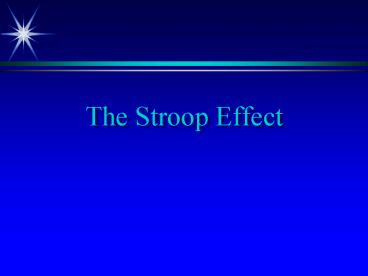The Stroop Effect - PowerPoint PPT Presentation
1 / 37
Title:
The Stroop Effect
Description:
... the effects of practice on the naming of ink colors of incompatible words over 8 days. Interference from incompatible words appeared to decrease with practice. ... – PowerPoint PPT presentation
Number of Views:5055
Avg rating:3.0/5.0
Title: The Stroop Effect
1
The Stroop Effect
2
- For the following words,
- say the ink color that
- the word is written in
3
RED
4
GREEN
5
RED
6
BLUE
7
GREEN
8
BLUE
9
GREEN
10
- How many of you had
- trouble saying the color that
- the word was written in?
11
- Did it take longer for you
- to name colors that were
- incongruent with the word?
12
- You have just experienced the Stroop Interference
Effect
13
Which takes longer to say aloud?
Apple
or
14
J. M. Cattell (1886)
- Cattell reported that objects (and colors) take
longer to name aloud than the corresponding words
take to read aloud.
15
J. M. Cattell (1886)
- This is because, in the case of words and
letters, the association between the idea and
name has taken place so often that the process
has become automatic, whereas in the case of
colors and pictures we must by a voluntary effort
choose the name (Cattell, 1886 p. 65)
16
Other support for differential practice
explanation
- Children younger than reading age, but who knew
the words for the colors used, were faster on
color naming than word reading
17
J. R. Stroop (1935)
- Interested in how best to explain interference.
- Was doing studies (similar to Cattells) looking
at color naming versus word reading when he got
the bright idea to combine the two attributes
into a single stimulus.
18
Stroops Primary Questions
- What effect does the word have on trying to name
the color and what effect does the color have on
trying to say the word? - What effect does practice have on the observed
interference?
19
Stroops Experiment 1
- Examined the effect of incompatible ink colors on
reading words aloud. - 2 conditions in which read word
- Experimental words in each of 4 other colors
- Control words printed in black
- No differences between the 2 conditions in RT so
no interference of color on reading words
20
Stroops Experiment 2
- Examined the effects of words when naming colors
- 2 conditions in which named color
- Experimental words in each of other 4 colors
- Control color blocks
- RT to name ink colors of incongruent words took
longer than solid-color squares suggesting a
significant interference effect.
21
Stroops Experiment 3
- Examined the effects of practice on the naming of
ink colors of incompatible words over 8 days - Interference from incompatible words appeared to
decrease with practice. - Additionally, all this practice resulted in a
temporary interference of incompatible ink colors
when reading words (reverse Stroop effect)
22
Stroops Conclusion
- A marked interference occurs when naming ink
colors of incompatible color words. - This interference may be the result of
differences in the strengths of associations
formed due to training levels in the two
activities.
23
Current form of Stroop Task
- Two conditions
- Ink color and Word color are congruent RED
- Ink color and Word color are incongruent RED
- Two Tasks
- Name ink color
- Name word
24
Conceptual Encoding Theory
- Seymours (1977) theory states that a color word
stimulus activates two conceptual codes in
semantic memory. - One corresponds to the color of the word (color
memory), and - the other to the color denoted by the word (word
memory).
25
Conceptual Encoding Theory
- The time to access the word memory is shorter
than the time to access the color memory and
transfer that information into the word. - Hence, when naming a word, there is no
interference from the ink color because it is
still processing. - But when you name the ink color, the word has
already been processed so you have to choose
between two answers resulting in longer RTs.
26
Conceptual Coding Theory
dog green red cat keyboard
RED GREEN BLUE PURPLE PINK
GREEN
BLUE
PURPLE
RED
PINK
Word Memory
Color Memory
27
Conceptual Encoding Theory
Incoming Stimulus
Green
Word Memory
Color Memory
28
Conceptual Encoding Theory
Green
Word
Color
Word Memory
Color Memory
29
Conceptual Encoding Theory
Green
Green
Word Memory
Color Memory
30
Conceptual Encoding Theory
Green
Green
Word Memory
Color Memory
31
Conceptual Encoding Theory
Green
Green
Word Memory
Color Memory
32
Conceptual Encoding Theory
Green
Green
Word Memory
Color Memory
33
Conceptual Encoding Theory
Green
Green
Word Memory
Color Memory
34
Conceptual Encoding Theory
- Which stimuli will take you longer to name the
color of the ink? - RED BLOOD
- This theory hypothesizes that it is more
difficult to say the ink color of a word when the
word itself names a color.
35
In closing...
- Although the differential practice theory is
commonly cited, to date there is no truly
adequate explanation as to why the Stroop effect
exists. - The case remains a mystery...
36
but the truth is out there.
37
End































